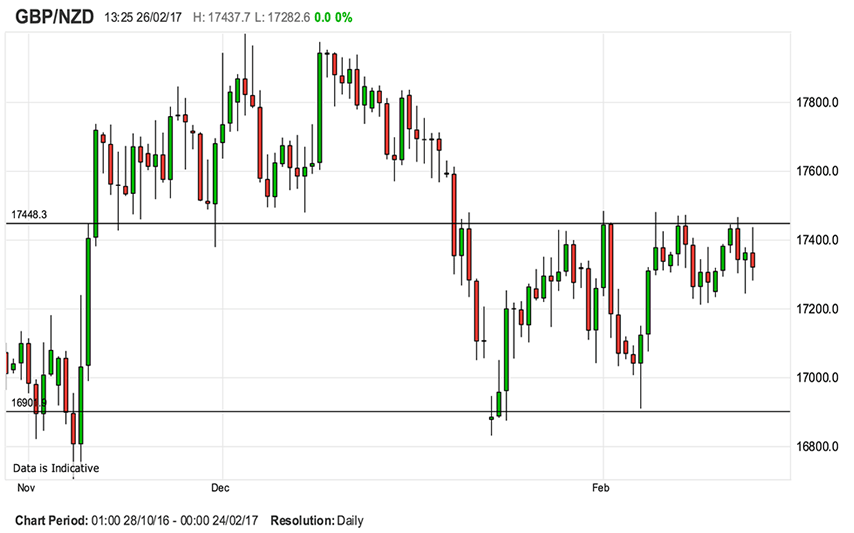New Zealand Dollar: Key Elements to Watch this Week
The New Zealand Dollar has been, alongside its Australian counterpart, one of the best-performing global currencies of 2017.
Against the US Dollar we see the exchange rate trading at 0.72, well off the lows towards 0.69 recorded at the start of the year.
The Pound to New Zealand Dollar exchange rate is meanwhile trading in the vicinity of 1.72-1.74.
This is some way above the all-time lows that are found sub-1.68, but in the bigger picture the NZ Dollar is clearly in a dominant position against Pound Sterling.
It’s no wonder that the New Zealand Dollar remains near historically expensive levels as the New Zealand economy is currently in a sweet spot:
“The economy has been growing at a steady pace, and we’re expecting above-trend GDP growth for the next couple of years. At the same time, inflation is looking very well contained,” says a note from Westpac Banking Corporation to clients dated 24 February.
New Zealand is now entering our seventh year of continued GDP growth.
“That’s one of the longest periods of continued expansion in New Zealand’s history. Looking ahead, we expect momentum in activity will be sustained for some time yet, with GDP growth of 3.6% forecast in 2017, and 3.4% in 2018,” say Westpac.
It is not hard to stay bullish on the New Zealand Dollar in light of the above.
In light of this we are forecasting the GBP/NZD exchange rate to remain constrained by the 1.7450 resistance area - we have not seen the exchange rate break above here in 2017.
While GBP/NZD rose in early February, gains have since become hard to come by as supply of Sterling increases in the run-up to the resistance zone.
Because of the resistance at 1.7450 there is a strong chance we move towards the middle of recent ranges over coming days, particularly if New Zealand data impresses.
NZ Data to Watch in the Coming Week
NZ February business confidence is released on February 28 at 00:00 GMT.
The last survey back in December showed that firms finished 2016 on a chipper note, indicative of continued strong growth through the final quarter of the year.
“This month’s survey will provide a vital update on how the economy has fared thus far this year. Against a backdrop of strong population growth, a large pipeline of construction and an improved outlook for the dairy sector, conditions should have remained favourable. However, tighter credit conditions and some cooling in the housing market may weigh on growth,” say Westpac in a brief to clients ahead of the release.
Last month, both inflation expectations and pricing intentions recorded notable increases.
“Whether we see further strong gains is important for the path of inflation from here. While it’s clear inflation has risen from its trough, we expect the rise back to 2% to be only gradual,” say Westpac.
New Zealand Q4 terms of trade are released on March 1, or February 28 at 21:45 GMT.
The terms of trade is estimated to have risen 3.7% in the December quarter, unwinding the decline seen over the previous six months.
The expected improvement is driven by an estimated 4.1% rise in export prices. Global dairy prices turned a corner in the second half of last year rising more than 50%, and these price gains began translating into export receipts in the December quarter.
Export prices of other commodities, including meat and forestry, also look to have strengthened.
Building consensus are released on March 3, or March 2 at 21:45 in the GMT time zone.
“We expect that nationwide construction levels declined by 1.0% in the December quarter. That follows strong growth earlier in 2016, and will still leave construction activity up more than 13% over the year,” say Westpac.
The UK this Week: Article 50 and PMIs
In the UK, the Article 50 bill looks set to continue its journey through Parliament. It moves to the committee stage of the House of Lords on Monday.
Most analysts see no reason why the bill cannot gain Royal Assent early next month, allowing the PM to invoke Article 50 by the end of March at the very latest.
On the data side the various PMIs will help markets to gauge the tone of the manufacturing, construction and services sectors.
Manufacturing PMI is released on Wednesday 1 March at 09:30 AM GMT and markets are forecasting a reading of 55.5.
Construction PMI on Thursday is forecast at 52.4.
Services PMI on Friday is forecast at 54.2.
The services sector data is particularly important as it will give a good indication as to whether the trend of softer data seen in 2017 is extending.
If so then Sterling could struggle.


